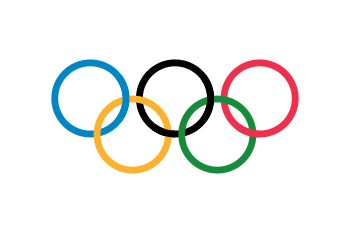Flag of Earth
Some individuals and organizations have promoted designs for a flag representing the planet Earth, though none have been officially recognized as such by any governmental body. The most widely recognized flags associated with Earth are the flag of the United Nations and the Earth Day flag. Listed below are some of the unofficial contenders for a Flag of Earth:
John McConnell's "Earth Day" flag
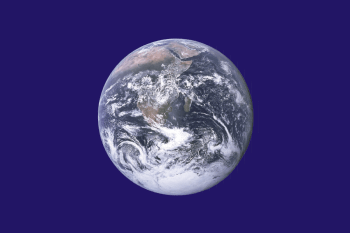

A flag designed by John McConnell in 1969 for the first Earth Day is a dark blue field charged with The Blue Marble, a famous NASA photo of the Earth as seen from outer space. The first edition of McConnell's flag used screen-printing and used different colors: ocean and land were blue and the clouds were white. McConnell presented his flag to the United Nations as a symbol for consideration.[1]
Because of the political views of its creator and its having become a symbol of Earth Day, the flag is associated with environmental awareness, and the celebration of the global community.[1] It was offered for sale originally in the Whole Earth Catalog, and is the only flag which was endorsed by McConnell.[2]
The Blue Marble image was placed in the public domain, and the public nature of this image was the basis of a legal battle that resulted in the invalidation of a trademark and copyright that was originally issued to the Earth Day flag through its original promotional entity, World Equity, Inc.[3] This does not invalidate the official history of McConnell's flag, only the official documentation that was issued on it.[1]
One Flag in Space
The One Flag in Space initiative is an offshoot of the Space Generation Congress (SGC), the Space Generation Advisory Council's yearly world meeting. It promotes usage of the Blue Marble flag for space exploration (it does not explicitly mention it being McConnell's design).
United Nations flag
Adopted in 1946, the flag of the United Nations has been used to indicate world unity, although it technically only represents the United Nations itself. It has a geographical representation of the planet, and its high visibility usage makes it a well-known contender for representing Earth. During the planning for NASA's moon landings of the 1960s, it was suggested that a UN flag be used in place of the flag of the US.[4]
"World Peace Flag" of Universal Peace Congress

James William van Kirk, a minister from Youngstown, Ohio, designed in 1913 a peace flag with rainbow stripes, stars and a globe. With this flag, he twice made a peace tour through Europe.[5] The Universal Peace Congress adopted this flag as its World Peace Flag.[6]
Olympic flag
Designed by Pierre de Coubertin in 1914 and adopted in Olympic games since 1920, the Olympic flag represents all mankind and has a white bar with 5 interlocking rings of 5 colors. The five rings represent the five continents.[7] The six colors (including the white color of the background) represent all of the world's nations.[8]
"World Citizen" flag of World Service Authority
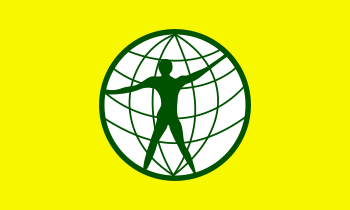
The World Citizen is a social movement for global citizenship under a proposed world government. In 1953, one of its activists, Garry Davis, founded the World Service Authority, which sells the World Passport (a fantasy travel document) with a proposed flag of the world.[9]
Astrological Symbol of Earth
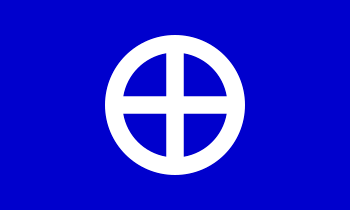
The astrological (and astronomical) symbol of Earth is another candidate for Earth's flag, often depicted with a blue background, with the symbol at its center.
Other private proposals
James W. Cadle's "Flag of Earth"
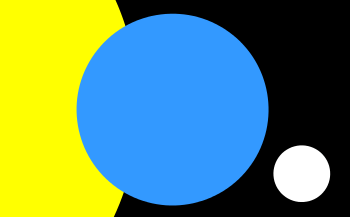
Another Earth flag was created around the same time in 1970 by a farmer from Homer, Illinois[10] named James W. Cadle. Cadle's version of the Earth flag consists of a blue circle representing Earth in the center of the flag, a segment of a large yellow circle representing the sun and a small white circle for the moon, all on a black background. It is particularly popular amongst SETI researchers and is used by SETI worldwide. The flag flies at the Ohio State University Radio Observatory and was lowered to half mast when Carl Sagan died.[11] Flag of Earth Co. International was also founded by Cadle which sold the flag. The Flag of Earth became public domain in 2003.[12]
Paul Carroll's "World Flag"
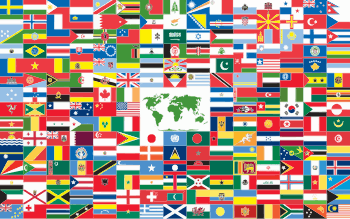
The World Flag is an international flag created in 1988 by Paul Carroll to act as a symbol to inspire "positive global change while continuing to embrace and celebrate cultural diversity.[13]" The current 2008 version of the combined World Flag has a world map 216 flags; including the flags of every UN member state, the United Nations, and several territories of larger nations.[13]
The World Flag has been flown at the UN Headquarters for the A Prayer for Peace event, The World Trade Center, Earth Day in Central Park, and at various other events around the world.[14][15]
Oskar Pernefeldt's "International Flag of the Planet Earth"

In 2015 a Swedish artist, Oskar Pernefeldt,[16] proposed the "International Flag of the Planet Earth".[17] It was conceived to be used in space expeditions and it has two main purposes:
- To be used while representing planet Earth.
- To remind the people of Earth that we share this planet, no matter of national boundaries. That we should take care of each other and the planet we live on.
The creators predict that it will be eventually used in Mars landing in 2025 or in a future colony on that planet. The flag is used by space research groups with intent to implanting a base on Mars.[18] The design of the flag consists of seven rings intersecting each other and a deep-blue-sea in the background. The rings are centered on the flag forming a flower in the middle, representing life on Earth. The intersection of the rings represent that all things on Earth are linked directly or indirectly. The rings are organized in a Borromean rings–like fashion, representing not only the seven continents, but how no part of Earth can be removed without the whole structure collapsing. Finally, the deep-blue represents the ocean and the importance of water for life on Earth.[19]
See also
References
- 1 2 3 Weir (2007). Peace, Justice, Care of Earth. Press On Publishing. ISBN 0971749124.
- ↑ "Authentic Earth Flag". Earthflag.net. Retrieved 2010-10-25.
- ↑ "Copyright Law - Copyrightability - Articles - Copyright Protection Not Available for Earth Flag".
- ↑ Platoff, Anne (August 2003). "Where No Flag Has Gone Before: Political and Technical Aspects of Placing a Flag on the Moon (NASA Contractor Report 188251)". National Aeronautics and Space Administration. Retrieved 2017-07-14.
- ↑ Corien Glaudemans, 'Een vredesapostel uit Ohio', in: Den Haag Centraal, 16 oktober 2009.
- ↑ Devere Allen, "The Fight for Peace". 1940. p.553.
- ↑ "The Olympic symbols" (PDF). International Olympic Committee. Retrieved 2014-02-08.
- ↑ http://www.olympic.org/Documents/Reports/EN/en_report_1303.pdf
- ↑ Table of travel documents entitling the holder to cross the external borders and which may be endorsed with a visa - (Parts II and II) and Part V (documents to which visas cannot be affixed. Council of the European Union. 1 December 2008. The World Passport is placed in the latter category.
- ↑ "The Flag of Earth - Flown".
- ↑ "Carl Sagan". Xs4all.nl. Retrieved 2010-10-25.
- ↑ Cadle, James W. "James Cadle's Flag of Earth Home Page". North American AstroPhysical Observatory (NAAPO). Retrieved 2018-04-02.
The Flag of Earth is now 34-years-old, and on November 1, 2003, became part of the public domain.
- 1 2 "Vision". WorldFlagProject.org. The World Flag Project. Retrieved 30 November 2015.
- ↑ "History". TheWorldFlag.org. The World Flag Project. Retrieved 30 November 2015.
- ↑ "Custom Flags". www.australianflagmakers.com.au.
- ↑ "The International Flag of the Planet Earth". Retrieved 22 May 2015.
- ↑ "Here's what the flag of Planet Earth could look like". Washington Post. Retrieved 23 May 2015.
- ↑ Pesquisador brasileiro visita estação no deserto que simula planeta Marte, Fantástico, November 12, 2017, 4 minutes and 26 seconds of video
- ↑ "Nusigma | This Could Become the Official Flag of Planet Earth". nusigma.in. Archived from the original on 2016-02-10. Retrieved 2016-02-08.
External links
| Wikimedia Commons has media related to Flags of Earth. |
- Authentic Earth Flag Website Official Website
- Authentic Earth Flag Endorsement John McConell's Endorsement of earthflag.net as the Authentic Earth Flag.
- The History of Earth Day and The Authentic Earth Flag by John McConnell
- Flags of the World
- James Cadle's "Flag of Earth" description
- Flag Of Planet Earth Proposal by artist Oskar Pernfeldt

